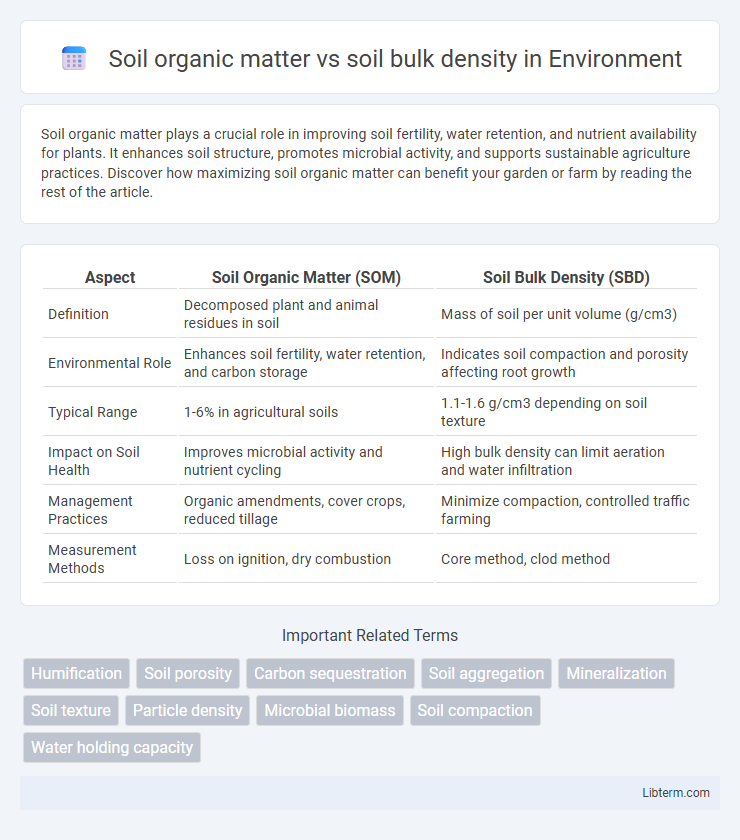Soil organic matter plays a crucial role in improving soil fertility, water retention, and nutrient availability for plants. It enhances soil structure, promotes microbial activity, and supports sustainable agriculture practices. Discover how maximizing soil organic matter can benefit your garden or farm by reading the rest of the article.
Table of Comparison
| Aspect | Soil Organic Matter (SOM) | Soil Bulk Density (SBD) |
|---|---|---|
| Definition | Decomposed plant and animal residues in soil | Mass of soil per unit volume (g/cm3) |
| Environmental Role | Enhances soil fertility, water retention, and carbon storage | Indicates soil compaction and porosity affecting root growth |
| Typical Range | 1-6% in agricultural soils | 1.1-1.6 g/cm3 depending on soil texture |
| Impact on Soil Health | Improves microbial activity and nutrient cycling | High bulk density can limit aeration and water infiltration |
| Management Practices | Organic amendments, cover crops, reduced tillage | Minimize compaction, controlled traffic farming |
| Measurement Methods | Loss on ignition, dry combustion | Core method, clod method |
Introduction to Soil Organic Matter and Bulk Density
Soil organic matter (SOM) is a critical component influencing soil structure, fertility, and water retention, composed primarily of decomposed plant and animal residues. Bulk density measures the mass of soil per unit volume, reflecting soil compaction and porosity, which directly affects root growth and air exchange. Understanding the relationship between SOM and soil bulk density is essential for optimizing soil health and crop productivity.
Defining Soil Organic Matter
Soil organic matter (SOM) refers to the decomposed remnants of plant and animal residues, microbial biomass, and humus that enrich soil fertility and structure. It plays a crucial role in reducing soil bulk density by increasing porosity and aggregation, which enhances water retention and root penetration. High SOM levels correlate with lower soil bulk density, promoting better aeration and nutrient availability essential for sustainable agriculture.
Understanding Soil Bulk Density
Soil bulk density measures the mass of soil per unit volume, directly influenced by the amount of soil organic matter, which decreases bulk density by increasing soil porosity. High soil organic matter improves soil structure, leading to lower bulk density values that enhance root penetration, water infiltration, and microbial activity. Accurately assessing bulk density is essential for evaluating soil compaction and fertility, as well as for managing sustainable agricultural practices.
Relationship Between Organic Matter and Bulk Density
Soil organic matter significantly influences soil bulk density by reducing it through the creation of a porous structure that enhances soil aggregation. Higher organic matter content decreases bulk density, improving soil aeration, water infiltration, and root penetration. Studies show soils with over 5% organic matter typically exhibit bulk densities below 1.2 g/cm3, while soils low in organic matter often have bulk densities exceeding 1.4 g/cm3, indicating compaction and reduced fertility.
Impact of Soil Organic Matter on Bulk Density
Soil organic matter significantly reduces soil bulk density by increasing soil porosity and aggregation, enhancing water retention and root penetration. Higher organic matter content improves soil structure, resulting in lower bulk density values that facilitate better aeration and microbial activity. Soils rich in organic matter typically exhibit bulk densities below 1.3 g/cm3, while mineral soils with low organic content often exceed 1.6 g/cm3.
Methods for Measuring Soil Organic Matter
Soil organic matter (SOM) content is commonly measured using dry combustion techniques like the CHN analyzer, which provides precise carbon quantification, or loss-on-ignition (LOI), where samples are heated to determine organic content by weight loss. Bulk density impacts SOM estimation by influencing soil volume and compaction; hence, core sampling methods ensure accurate bulk density measurements to calculate SOM on a volumetric basis. Combining SOM quantification with bulk density data allows for precise evaluation of soil carbon stocks and soil health assessment.
Techniques for Determining Soil Bulk Density
Techniques for determining soil bulk density include the core method, which involves extracting a known volume of soil with a metal cylinder and measuring its dry mass to estimate density accurately. The clod method uses waterproof plaster or paraffin to coat a soil aggregate, allowing volume displacement measurements essential for calculating bulk density. Advanced tools like gamma-ray attenuation and X-ray computed tomography provide non-destructive, high-precision assessments by analyzing soil density variations and internal structure.
Effects on Soil Structure and Porosity
Soil organic matter significantly improves soil structure by promoting aggregation, which increases porosity and enhances aeration and water retention. Higher soil organic matter reduces soil bulk density, resulting in looser, more friable soil that supports root growth and microbial activity. Conversely, low soil organic matter often correlates with increased bulk density, leading to compaction, reduced pore space, and diminished soil permeability.
Management Practices to Improve Soil Quality
Management practices such as cover cropping, reduced tillage, and organic amendments increase soil organic matter, which in turn decreases soil bulk density by improving soil structure and porosity. Incorporating crop residues and applying compost enhance microbial activity and aggregate stability, leading to lower bulk density and better water retention. Regularly rotating crops and maintaining continuous ground cover prevent soil compaction, promoting favorable bulk density conditions essential for root growth and nutrient uptake.
Conclusion: Balancing Organic Matter and Bulk Density
Soil organic matter plays a critical role in reducing soil bulk density by improving soil structure, porosity, and aggregation. Maintaining an optimal balance between soil organic matter and bulk density enhances water retention, root penetration, and microbial activity, leading to improved soil fertility and crop productivity. Effective soil management strategies prioritize increasing organic matter inputs to counteract compaction and promote sustainable soil health.
Soil organic matter Infographic

 libterm.com
libterm.com